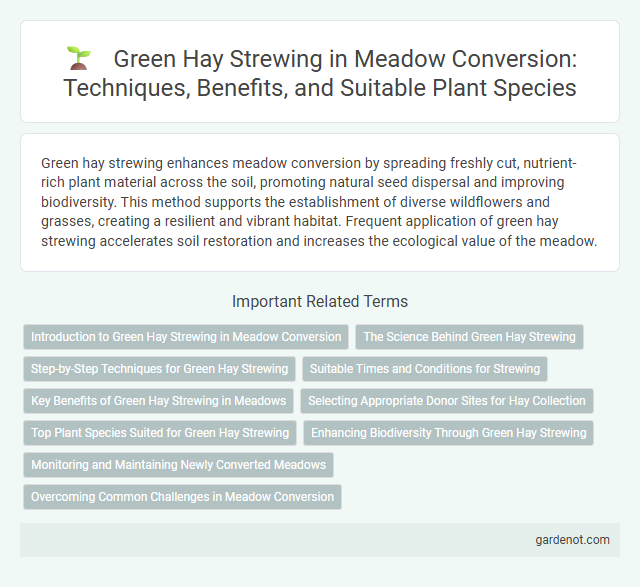Green hay strewing enhances meadow conversion by spreading freshly cut, nutrient-rich plant material across the soil, promoting natural seed dispersal and improving biodiversity. This method supports the establishment of diverse wildflowers and grasses, creating a resilient and vibrant habitat. Frequent application of green hay strewing accelerates soil restoration and increases the ecological value of the meadow.
Introduction to Green Hay Strewing in Meadow Conversion
Green hay strewing is a traditional meadow conversion technique that involves spreading freshly cut, species-rich green hay over prepared soil to establish diverse grassland habitats. This method accelerates the introduction of native wildflowers and grasses, enhancing biodiversity and ecosystem resilience. It is particularly effective in restoring degraded meadows and supporting pollinator populations by promoting species-rich swards.
The Science Behind Green Hay Strewing
Green hay strewing involves spreading freshly cut, green plant material from species-rich meadows onto target restoration sites to introduce diverse native flora. This method transfers viable seeds and soil microbes, promoting natural regeneration by mimicking traditional hay meadow ecosystems. Studies show that green hay strewing enhances biodiversity, improves soil health, and accelerates habitat restoration compared to artificial seeding techniques.
Step-by-Step Techniques for Green Hay Strewing
Green hay strewing involves cutting a flowering meadow at peak bloom, drying the green hay for several hours to maintain seed viability, and distributing it evenly over the target restoration site. Timing the collection to coincide with optimal seed ripeness ensures high germination rates, while spreading the hay by hand or using agricultural machinery promotes natural species diversity. Frequent monitoring of soil moisture and post-strewing management such as light grazing or mowing helps establish a sustainable, biodiverse meadow ecosystem.
Suitable Times and Conditions for Strewing
Green hay strewing is most effective during late spring to early summer when meadow vegetation is rich in seeds and moisture levels support seed viability. Optimal conditions include dry weather for at least 48 hours to prevent mold growth and avoid heavy rain, which can wash away seeds or reduce germination rates. Strewing should be carried out when soil temperatures rise above 10degC (50degF) to ensure seed germination and establishment.
Key Benefits of Green Hay Strewing in Meadows
Green hay strewing enhances meadow biodiversity by introducing a mix of native wildflower seeds directly onto the soil, promoting natural regeneration. This process improves soil health and increases plant species richness, supporting pollinators and other wildlife. Green hay strewing also strengthens ecosystem resilience, making meadows more adaptable to climate variations.
Selecting Appropriate Donor Sites for Hay Collection
Selecting appropriate donor sites for green hay strewing involves identifying species-rich meadows with high floristic diversity to maximize seed transfer success. The donor site should have similar soil conditions and hydrology to the restoration area to ensure compatibility and promote healthy plant establishment. Timing hay collection during peak flowering seasons is crucial to capture mature seed bank diversity for effective meadow conversion.
Top Plant Species Suited for Green Hay Strewing
Top plant species suited for green hay strewing include native grasses such as Timothy (Phleum pratense), Meadow Fescue (Festuca pratensis), and Red Clover (Trifolium pratense), which promote biodiversity and soil health. Forbs like Oxeye Daisy (Leucanthemum vulgare) and Bird's-foot Trefoil (Lotus corniculatus) enhance nectar availability for pollinators. Selecting species with high germination rates and adaptability to local soil conditions ensures successful meadow conversion through green hay strewing.
Enhancing Biodiversity Through Green Hay Strewing
Green hay strewing involves spreading freshly cut, species-rich meadow vegetation onto bare soil to promote natural seed dispersal and plant establishment. This traditional technique enhances biodiversity by increasing the variety of native flora, which supports diverse insect and wildlife populations. Implementing green hay strewing in meadow conversion projects accelerates habitat restoration and fosters resilient ecosystems.
Monitoring and Maintaining Newly Converted Meadows
Green hay strewing requires precise timing and careful monitoring to ensure successful establishment of plant species in newly converted meadows. Regular assessments of soil moisture, seed germination rates, and vegetation growth patterns help maintain optimal conditions for diverse meadow flora development. Effective maintenance practices include selective mowing and controlling invasive species to promote native biodiversity and long-term meadow sustainability.
Overcoming Common Challenges in Meadow Conversion
Green hay strewing effectively supports meadow conversion by introducing diverse, locally adapted native grasses and wildflowers, enhancing biodiversity and ecosystem resilience. Overcoming common challenges such as seed viability, timing of harvest, and site preparation involves precise management practices to maximize germination and establishment. Employing specialized equipment for even distribution and monitoring soil conditions ensures successful integration of green hay into degraded meadows.
Green hay strewing Infographic

 gardenot.com
gardenot.com